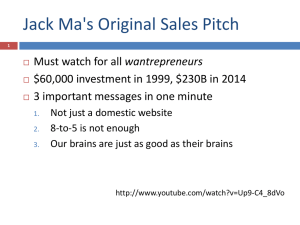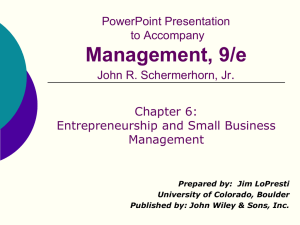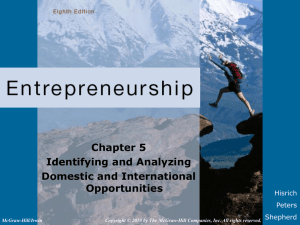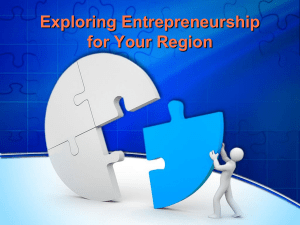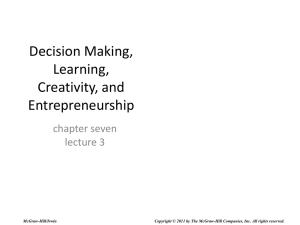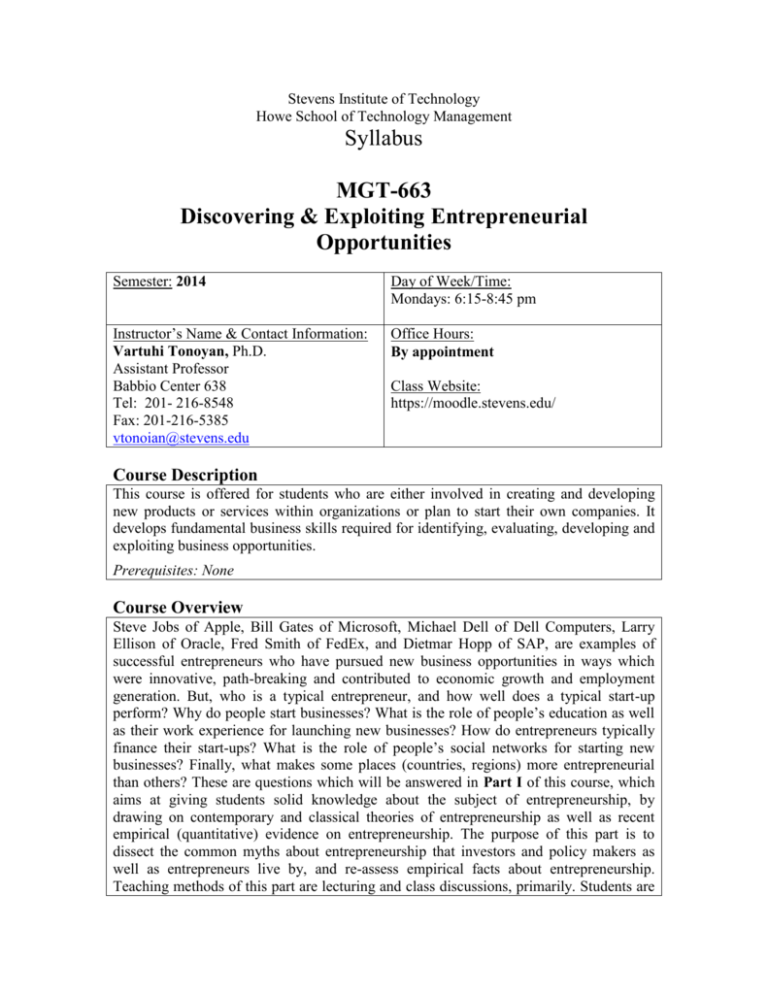
Stevens Institute of Technology
Howe School of Technology Management
Syllabus
MGT-663
Discovering & Exploiting Entrepreneurial
Opportunities
Semester: 2014
Day of Week/Time:
Mondays: 6:15-8:45 pm
Instructor’s Name & Contact Information:
Vartuhi Tonoyan, Ph.D.
Assistant Professor
Babbio Center 638
Tel: 201- 216-8548
Fax: 201-216-5385
vtonoian@stevens.edu
Office Hours:
By appointment
Class Website:
https://moodle.stevens.edu/
Course Description
This course is offered for students who are either involved in creating and developing
new products or services within organizations or plan to start their own companies. It
develops fundamental business skills required for identifying, evaluating, developing and
exploiting business opportunities.
Prerequisites: None
Course Overview
Steve Jobs of Apple, Bill Gates of Microsoft, Michael Dell of Dell Computers, Larry
Ellison of Oracle, Fred Smith of FedEx, and Dietmar Hopp of SAP, are examples of
successful entrepreneurs who have pursued new business opportunities in ways which
were innovative, path-breaking and contributed to economic growth and employment
generation. But, who is a typical entrepreneur, and how well does a typical start-up
perform? Why do people start businesses? What is the role of people’s education as well
as their work experience for launching new businesses? How do entrepreneurs typically
finance their start-ups? What is the role of people’s social networks for starting new
businesses? Finally, what makes some places (countries, regions) more entrepreneurial
than others? These are questions which will be answered in Part I of this course, which
aims at giving students solid knowledge about the subject of entrepreneurship, by
drawing on contemporary and classical theories of entrepreneurship as well as recent
empirical (quantitative) evidence on entrepreneurship. The purpose of this part is to
dissect the common myths about entrepreneurship that investors and policy makers as
well as entrepreneurs live by, and re-assess empirical facts about entrepreneurship.
Teaching methods of this part are lecturing and class discussions, primarily. Students are
additionally expected to deliver a term paper in teams of two, having interviewed a hightech start-up. This semester’s focus will be put on App-Preneurship. Research questions
revolving around App-Preneurship, as well as guidelines and requirements of the group
term paper will be announced early in the course.
Part II of this course aims at providing students with practical skills for setting up
businesses and is suitable for those who may want to undertake an entrepreneurial career
either by pursuing opportunities which lead to partial or full ownership of a business or
those who consider becoming an entrepreneurial consultant and/or venture capitalist. It
focuses on the creation of a new venture by providing frameworks and applying them to
the identification and pursuit of a viable business opportunity. Employing a dynamic
perspective, we will deal with issues revolving around the birth, growth and exit of newly
founded companies. Concepts include the new venture formation process, opportunity
identification, evaluation and analysis, customer development, market research, business
models, managing intellectual property, entrepreneurial finance, as well as growth and
exit strategies of newly established entrepreneurial companies. This part will be taught by
the “case method”, primarily. We will draw on real-life cases which have previously been
employed at the Harvard Business School and the Stanford University’s Graduate School
of Business.
In Part III of the course, students are expected to develop and write a business plan in
teams of two as well as pitch their ideas in front of the class.
Course Objectives
This course prepares students for their careers as future (technology) entrepreneurs and/or
venture capitalists who consult on the strategic management of new and established
businesses in technology-intensive industries. It provides frameworks for analyzing key
aspects of these industries and teaches students how to apply these frameworks in reallife situations.
Additional learning objectives includes the development of:
Analytical Problem Solving Skills: Students will be able to critically evaluate, analyze
and interpret information for solving issues pertaining to technology entrepreneurship and
innovation. They will be able to understand contemporary and classical theories of
entrepreneurship as well as recent empirical (quantitative) evidence on the subject, and
thus tools that would enable them to critically evaluate, analyze and interpret information
about the (1) the source, discovery, the evaluation of entrepreneurial and technological
opportunities; (2) the provision of products and services that satisfy the needs of
customers; (3) the development of mechanisms to appropriate the returns from the
exploitation of the opportunity; and (4) the organizational efforts of entrepreneurial
companies to innovate.
Team Skills: Students work together in teams on the final project which is the
development of the business plan.
2
Communication Skills: Students have to pitch their business idea.
Course Outcomes
After taking this course, students will be able to:
1.
2.
3.
4.
5.
6.
7.
8.
Identify and recognize viable business opportunities.
Critically evaluate business opportunities.
Develop a business model.
Present effectively the business idea.
Assess and obtain required resources.
Manage growth of new ventures.
Define exit strategies.
Develop and write a business plan.
Pedagogy
The course will employ lectures, case studies, class discussions, mid-term exam, and a
team project. Since “one size does not fit all”, we will use a variety of teaching methods
which are designed to give you the breadth and depth of skills and experience you will
need for successfully pursuing an entrepreneurial career. They include the following:
Lecturing, theoretical and empirical overviews
Class discussions
Case studies
Role-plays
Team projects
Problem-solving sessions
Face-to-face feedback
Required Text(s)
Shane, S. (2008). Technology Strategy for Managers and Entrepreneurs. Pearson:
Prentice Hall.
Shane, S. (2003). A General Theory of Entrepreneurship: The Individual-Opportunity
Nexus. Edward Elgar, Cheltenham, UK and Northampton, MA, USA.
Required Readings
Cases
All cases for every single session can be found in the reading packet. Some cases may be
distributed during the term because they are still being revised. We typically assign
3
readings that we expect you to complete in advance of each class.
Assignments
The course assignments consist of following distinctive deliverables.
Class Participation
This course depends heavily on class participation and discussions. Cases expose the
ambiguities that are part and parcel of any decision, and the issues involved in going from
principles to practices. Case discussions also develop the skills of persuasion, analysis
and listening that are keys to the success of any entrepreneur and manager.
You must prepare for class and participate in order for the course to be successful.
Preparation for class -especially important for Part II of this course- involves a) reading
the assigned cases and background materials thoroughly and b) reviewing and answering
for yourself the case assignment questions.
If you have not carefully thought about the study questions, you are not prepared for
class. You are welcome to discuss cases with other students currently enrolled in the
class, but the analysis must be your own. In preparing for case discussions, consulting
students who have previously taken the class, or consulting teaching notes prepared by
anyone, prior slides or notes from any class, or any other material (with the exception of
what you would otherwise read in the business press) constitutes a violation of the honor
code at the Stevens Institute of Technology.
You can contribute to the class discussion in different ways: through clarifying questions,
relevant personal experiences as well as critical evaluations of the argument and
evidence. Your participation can take three specific forms.
Identifying the key issues in the case, drawing on your reading of the case and
additional readings.
Concisely explaining and justifying your preferred course of action.
Listening to the contributions of your classmates and engaging them in
constructive dialogues.
Your participation will be evaluated after each class. I will use a four-point scale: (0)
missed class, (1) attended class, (2) participated in the case discussion, or (3) made a
significant contribution to the case discussion. “Significant contributions” can take a
variety of forms, including moving the discussion forward, making insightful comments
as well as connections to course materials. The quality of your contribution is far more
important than the quantity. Note that repeated absences can have large negative effect on
the overall participation grade.
I expect you to be prepared for class each week. I will often cold call on people. If, for
some reason, you are not adequately prepared for class and do not wish to be called on,
please tell me prior to the beginning of class. Given the size of the class, it may not be
4
feasible for you to participate every week; however, to get the most out of the class and
be ready for cold calls, you should be highly prepared for every session.
Midterm
The midterm exam will be an individual, a 60-minutes, closed-book and closed-notes
written exam administered in class in Week 9 after Spring Recess. The exam will consist
of two tasks, each of them including three questions. You are expected to choose one of
the two tasks and provide answers to the questions. The criteria which I will use for
assessing your midterm exam answers are as follows:
Your statements should answer the question(s) asked.
Your answer should be well-structured, i.e. it should have a brief introduction,
problem statement and a brief conclusion.
When appropriate, you should discuss more than one view, theory or perspective.
Your answer should logically develop an argument in an analytical manner. You
may back up your answer with real-life examples or research studies which we
have discussed in Part I of this course. Your answer may include original and
creative thought, but only if it is relevant. You may draw comparisons to other
business-related subjects.
Your answer should be legible and well written. Care should be taken over use of
English (sentences, paragraphs, grammar, spelling and general presentation etc.).
Please be sure to bring your Stevens’ ID # to class for the exam.
If you cannot take the mid-term exam for legitimate reasons, you should contact me prior
to the exam or as soon as possible. It is your responsibility to provide evidence of a
legitimate reason. Among these are e.g. an illness treated by a physician who will put in
writing that you were too ill to take the exam; a death in the family or an accident that
prevented your attendance at the scheduled time. In the event of an excused missed exam,
it is the student’s responsibility to contact the professor to schedule a make-up exam date.
For an unexcused absence of an exam, I will give you a grade of zero.
Group Project: New Venture Business Plan
Your final assignment will be a group project. For this project, you -in teams of two- will
develop a complete business plan. The format for your business plan will be offered in
the course. Groups should feel free to meet me to discuss their business idea. I may be
able to help you assess the feasibility of your business ideas, suggest useful sources of
information to consult for improving your business plan, etc.
You are free to form your teams as you wish. However, the composition of groups cannot
change after week 11. Your final business plan is due Thursday, May 2, by 5.00 pm. You
are expected to email it to me at vtonoian@stevens.edu. Your assignment will only be
accepted if it was submitted within the due date. Please note that your assignments may
be submitted to a web-based anti-plagiarism control system for an evaluation of their
5
originality. You will pitch your business idea on Tuesday, April 30. The presentation of
the business idea must be less than 2 min.
Assignments
1. Class Participation
2. Midterm Exam
3. Group Term Paper
4. Team Business Plan
5. Pitching
Total Points
Grade
Points
20
30
30
15
5
100
Ethical Conduct
The following statement is printed in the Stevens Graduate Catalog and applies to all
students taking Stevens courses, on and off campus.
“Cheating during in-class tests or take-home examinations or homework is, of course,
illegal and immoral. A Graduate Academic Evaluation Board exists to investigate
academic improprieties, conduct hearings, and determine any necessary actions. The
term ‘academic impropriety’ is meant to include, but is not limited to, cheating on
homework, during in-class or take home examinations and plagiarism.“
Consequences of academic impropriety are severe, ranging from receiving an “F” in a
course, to a warning from the Dean of the Graduate School, which becomes a part of the
permanent student record, to expulsion.
Reference:
The Graduate Student Handbook, Academic Year 2003-2004 Stevens
Institute of Technology, page 10.
Consistent with the above statements, all homework exercises, tests and exams that are
designated as individual assignments MUST contain the following signed statement
before they can be accepted for grading.
____________________________________________________________________
I pledge on my honor that I have not given or received any unauthorized assistance on
this assignment/examination. I further pledge that I have not copied any material from a
book, article, the Internet or any other source except where I have expressly cited the
source.
Signature ________________
Date: _____________
Please note that assignments in this class may be submitted to www.turnitin.com, a webbased anti-plagiarism system, for an evaluation of their originality.
6
Course Schedule & TOPICS
The lecture topics could be changed in accordance to the possibility to invite guest
speakers. Additional readings will be submitted in class.
WEEK
Date
Probable Lecture Topic
1
01/14/2014
01/16/2014
INTRODUCTION TO THE COURSE AND
NATURE OF ENTREPRENEURSHIP
2
01/21/2014
1.Defining Entrepreneurship
2.The Entrepreneurial Process / A Life-Cycle
Perspective on New Firms
3. Why Approaching Entrepreneurship As a
Process Is Central to this Course?
LECTURE: THEORIES OF
ENTREPRENEURSHIP BY SCHUMPETER,
KIRZNER AND KNIGHT
-
-
-
2
01/23/2014
Reading for this
class
Shane (2003),
Chapter 2 “The Role
of Opportunities”
Theory of Economic Growth
(Schumpeter 1934)
Entrepreneurial
Discovery
and
Competitive Market Process (Kirzner
1997)
Comparison between Kirznerian and
Schumpeterian Opportunities, Their
Sources and Forms
Risk, Uncertainty, and Profit (Knight
1921)
LECTURE: PSYCHOLOGICAL
DETERMINANTS OF
ENTREPRENEURSHIP: ASPECTS OF
PERSONALITY AND MOTIVES, CORE
SELF-EVALUATION, AND COGNITIVE
CHARACTERISTICS
-
Aspects of Personality and Motives:
Extraversion; Agreeableness; Need
for
Achievement;
Risk-Taking
Propensity; Desire for Independence
- Core Self-Evaluation: Internal Locus
of Control and Self-Efficacy
- Cognitive
Characteristics:
Overconfidence; Representativeness;
and Intuition
LECTURE: ECONOMIC DETERMINANTS
OF ENTREPRENEURSHIP. ON THE ROLE
OF OPPORTUNITY COSTS, EDUCATION,
AND CAREER EXPERIENCE FOR THE
DECISION TO BECOME ENTREPRENEUR
1.
Deliverable
Shane
(2003),
Chapter
5
“Psychological
Factors
and
the
Decision To Exploit”
Shane (2003),
Chapter 4
“Individual
Differences and the
Decision to Exploit”
Opportunity Costs and the Decision
to Become Entrepreneur
1.1. Income
1.2. Unemployment Duration and
7
Unemployment Coverage
Human Capital and the Decision to
Become Entrepreneur
2.1. Education
2.2. Career Experience: General
Business Experience; Functional
Experience; Industry Experience;
Self-Employment Experience; and
Learning by Imitation
3. Balanced
Skills
and
Entrepreneurship (Lazear 2004)
2.
3
01/28/2014
CASE: BILL GATES & STEVE JOBS
Discussion Questions:
1. How have Gates and Jobs shaped
technology? How has technology
shaped them and their companies?
2. Compare the leadership styles and
approaches of Gates and Jobs. In
what ways are they similar?
Different?
3. Who do you believe is the better
business leader?
4. Who would you want to work for?
Who would you want to work for
you?
5. How does a charismatic founder
transition a company for long-term
success?
DISCUSSION OF GROUP TERM PAPER
TOPICS ON APP-PRENEURSHIP
3
01/30/2014
CASE: R&R
Discussion Questions:
-
-
-
4
02/04/2014
What factors created an opportunity
for Bob Reiss and the “TV Guide
Game”?
What risks and obstacles had to be
overcome in order to pursue the
opportunity successfully? How did
Bob Reiss accomplish this?
Would this approach have worked
for Parker Bros., or Milton Bradley?
As a result of this success, what
should Reiss do now?
LECTURE: ECONOMIC DETERMINANTS
Financing New
8
02/06/2014
OF ENTREPRENEURSHIP (CONTINUED) :
ENTREPRENEURIAL FINANCE
1.
2.
Sources of Funding
Valuation Methods
LECTURE: SOCIOLOGICAL
DETERMINANTS OF
ENTREPRENEURSHIP: ON THE ROLE OF
STRONG AND WEAK TIES, AND AGE
FOR DECISION TO BECOME
ENTREPRENEUR
Ventures (Kerr &
Nanda, HBR Article)
Shane (2003),
Chapter 4, General
Theory of
Entrepreneurship:
IndividualOpportunity Nexus.
1. On the Importance of “Strong Ties”
Versus “Weak Ties” for
Entrepreneurship
1.1. Parental Self-Employment
1.2. Spousal Self-Employment
1.3. Business
Networks
and
Voluntary Organizations
2. The Link between Age and
Entrepreneurship
5
02/11/2014
02/13/2014
LECTURE: EVOLUTION OF
TECHNOLOGY
-
Evolutionary Patterns of
Development
- Radical and Incremental
Technological Change
- Technology S-Curves
- The Abernathy-Utterback Model
- Modifications to the AbernathyUtterback Model: Reverse Product
Cycle Theory, CompetenceEnhancing and CompetenceDestroying Innovation, Architectural
Innovation, Disruptive Technology
and Value Networks
CASE: E-INK in 2005
Shane (2008),
Chapter 2,
Technology Strategy
for Entrepreneurs
and Managers
Discussion Questions:
1. What did e-Ink do right? What did it
do wrong? What might they have done
differently?
2. As a VC, would you invest in e-Ink
today?
Assuming the company gets the money it
needs to stay alive, what do you do as CEO?
Which markets would you attack? Which
business models would you adopt?
9
6
7
02/20/2014
02/25/2014
02/27/2014
Practicum
LECTURE: TECHNOLOGY
AND DIFFUSION
ADOPTION
-
Distribution of Adopters: Group of
Adopters and S-Curves of Adopters
- Crossing the Chasm: Identifying the
Take-Off Stage; How To Cross the
Chasm; Choosing the Customer;
Beachhead Strategy
- Market
Dynamics:
Forecasting
Demand; Information Diffusion
Models; How Not to Do it; The Bass
Model; The Delphi Technique
- Product Diffusion Models
- The Importance of Complementary
Technologies
- Substitution
CASE: FORECASTING THE ADOPTION
OF E-BOOKS
Shane (2008),
Chapter 3,
Technology Strategy
for Entrepreneurs
and Managers
Harvard Business
Note: “Forecasting
the Adoption of a
New Product” (HBS9-505-062)
Discussion Questions:
1. An e-book is an electronic book (i.e.
file containing the book content) that
can be downloaded and read on many
digital devices (e.g. desktop
computer, laptop, PDA, or other
dedicated e-books online), similar to
the purchase of a song title online.
Prepare a 25-year forecast for the
adoption of e-books. Follow the
exercise on “Forecasting the
Adoption of E-books”.
2. Be prepared to justify your forecast in
class and to discuss your thinking on
the questions/points to consider at the
end of the exercise on the e-books.
8
03/04/2014
03/06/2014
LECTURE: SOURCES OF INNOVATION
AND
GENERATION
OF
ENTREPRENEURIAL IDEAS
-
-
-
Sources
of
Opportunities:
Technological Change; Political and
Regulatory Change; Social and
Demographic Changes
Locus of Innovation
Research and Development: Types of
R&D, Why Firms Invest in R&D,
Costs of R&D, Linking Research and
Development
Forms of Innovation: Forms of
Innovation and Technology Strategy;
Industry and the Nature of
Shane (2008),
Chapter 4,
Technology Strategy
for Entrepreneurs
and Managers
10
Innovation
CASE: THREE DIMENSIONAL PRINTING
Discussion Questions:
1. Why did the entrepreneurs discover
opportunities in the 3DP process?
2. Why did so few people discover
opportunities to exploit MIT’s 3DP
Process?
3. Why did the different entrepreneurs
in the case discover such different
opportunities for the 3DP Process?
4. How
are
the
entrepreneurial
opportunities
to
exploit
3DP
different? What effect do these
differences have on the evaluation
and pursuit of those opportunities?
9
03/08/2014
GROUP TERM PAPER DUE ON APPPRENEURSHIP
11
03/18/2014
03/20/2014
PRESENTATION AND DISCUSSION OF
THE GROUP PROJECT RESULTS
1. Prepare power point slides for a 20
min presentation. Your presentation
should highlight the title of your
paper,
its
structure,
research
questions, findings, as well as
implications for future research and
entrepreneurs
2. Be prepared for a 10-min discussion
of your findings
EXAM PREPARATION
IN-CLASS,
CLOSED-BOOK
AND
CLOSED-NOTES
MID-TERM
EXAM
(Note: Only Part I will be relevant for your
mid-term exam)
12
03/25/2014
12
03/27/2014
LECTURE: WRITING BUSINESS PLANS
AND PITCHING BUSINESS IDEAS
13
04/8/2014
04/10/2014
CASE: ZIPCAR: REFINING THE
BUSINESS MODEL
Sahlman, W. (1997),
Some Thoughts on
Business Plan, HBS
Note 9-897-101
Discussion Questions:
1. Evaluate the potential venture and
the progress that Chase has made.
2. What is the business model, and
how has it changed between
11
December 1999 and May 2000?
What do the data from actual
operations in September say about
how the business model is playing
out in practice? Does this data give
you comfort or concern?
3. What actions should Chase take as
a result of the September operating
results?
4. What is the strongest argument
Chase could make to a potential
investor about the attractiveness of
the venture? What, specifically,
should her elevator pitch be at the
Springboard forum?
14
04/15/2014
04/17/2014
EXERCISE: BUSINESS MODEL CANVAS
LECTURE: ENTREPRENEURIAL
MARKETING
1. Technology Push versus Market Pull
2. Understanding Customer Needs
3. Pricing Products Correctly
4. Market Segmentation
5. Market Research
CASE: ZENITH - MARKETING
RESEARCH FOR HIGH DEFINITION
TELEVISION
Shane (2008),
Chapter 6,
Technology Strategy
for Entrepreneurs
and Managers
Discussion Questions:
1. How much of existing information
on TV buyers can be used to assess
the HDTV market?
2. What are the forecasts of HDTV
demand from 1992-2000 under a
Pessimistic, Most Likely, and
Optimistic Scenarios? How to
define these Scenarios?
3. Should Zenith do the Aspect Ratio
Study?
4. What additional market research
should be done to assess market
potential/consumer preference for
HDTV?
15
04/22/2014
LECTURE: INTELLECTUAL PROPERTY
RIGHTS PROTECTION THROUGH
TRADE SECRETS, TRADEMARKS, AND
COPYRIGHTS
1. Secrecy
2. Copyrights
12
3. Trademarks
4. International Issues in Intellectual
Property
CASE: CADENCE VERSUS AVANT!
Discussion Questions:
1. What forces are shaping the EDA
industry? How have these forces
contributed to the current legal
showdown?
2. Put yourself in Joe Costello’s
position. How could you have
better protected your company’s
intellectual property? How should
you proceed with the current
situation?
3. Put yourself in Gerald Hsu’s
position. How could you have
better developed the requisite
intellectual property while
protecting Avant! from legal
problems? How should you respond
to the latest Cadence lawsuit?
4. Put yourself in the position of a
venture capitalist Avant! Board
member. What are your
responsibilities relating to
intellectual property development?
What should you do now?
15
04/24/2014
CASE:
QI-TECH:
A
CHINESE
TECHNOLOGY COMPANY FOR SALE
Discussion Questions:
1. What are the objectives of different
parties on the seller’s side?
Specifically, what are the objectives
of Indivers? Of QI-tech’s local
management? Of QQMF? Of Roger
Kollbrunner?
2. What is the value of Indiver’s stake
in QI-TECH?
3. What negotiation strategy should
Kollbrunner pursue in their
negotiation with Brown & Sharpe
(the potential buyer)? What price
should they ask for?
4. What concerns might Phil James,
VP of Brown & Sharpe’s CMM
division, have? How can the seller
13
mitigate these concerns?
5. What should Roger Kollbrunner do
next?
6. What general lessons regarding the
management of joint ventures in
entrepreneurial setting can you
draw from this case?
16
04/29/2014
05/01/2014
FINAL TEAM PITCHING AND
DISCUSSIONS
SUBMISSION OF BUSINESS PLANS
14





